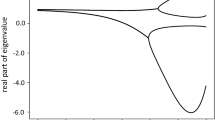Abstract
The Halo orbits originating in the vicinities of both,L 1 andL 2 grow larger, but shorter in period, as they shift towards the Moon. There is in each case a narrow band of stable orbits roughly half-way to the Moon. Nearer to the Moon, the orbits are fairly well-approximated by an ‘almost rectilinear’ analysis. TheL 2 family shrinks in size as it approaches the Moon, becoming stable again shortly before penetrating the lunar surface. TheL 1-family becomes longer and thinner as it approaches the Moon, with a second narrow band of stable orbits with perilune, however, below the lunar surface.
Similar content being viewed by others
References
Farquhar, R. W. and Kamel, A. A.: 1973, ‘Quasi-Periodic Orbits About the Translunar Libration Point’,Celest. Mech. 7, 458.
Farquhar, R. W.: 1970, ‘The Control and Use of Libration-Point Satellites’, NASA TR R-346.
Breakwell, J. V.: 1973, ‘Trajectories Launched Normal to the Elliptic’, Proc. of the XIV International Astronautical Congress; Paris.
O'Neill, G. K.: 1974, ‘The Colonization of Space’,Physics Today.
Author information
Authors and Affiliations
Rights and permissions
About this article
Cite this article
Breakwell, J.V., Brown, J.V. The ‘Halo’ family of 3-dimensional periodic orbits in the Earth-Moon restricted 3-body problem. Celestial Mechanics 20, 389–404 (1979). https://doi.org/10.1007/BF01230405
Received:
Accepted:
Issue Date:
DOI: https://doi.org/10.1007/BF01230405




